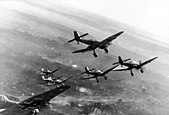
Back Tweede Wêreldoorlog Afrikaans Zweiter Weltkrieg ALS 2ኛው ዓለማዊ ጦርነት Amharic Segunda Guerra Mundial AN Ōðru Woruldgūþ ANG الحرب العالمية الثانية Arabic لحرب لعالمية الجاوجة ARY الحرب العالميه التانيه ARZ দ্বিতীয় বিশ্বযুদ্ধ Assamese Segunda Guerra Mundial AST
| World War II | |||||||
|---|---|---|---|---|---|---|---|
| |||||||
| |||||||
| Participants | |||||||
| Allies | Axis | ||||||
| Commanders and leaders | |||||||
| Main Allied leaders: | Main Axis leaders: | ||||||
| Casualties and losses | |||||||
|
| ||||||
| World War II |
|---|
| Navigation |
|
|
World War II[b] or the Second World War (1 September 1939 – 2 September 1945) was a global conflict between two coalitions: the Allies and the Axis powers. Nearly all the world's countries—including all the great powers—participated, with many investing all available economic, industrial, and scientific capabilities in pursuit of total war, blurring the distinction between military and civilian resources. Tanks and aircraft played major roles, with the latter enabling the strategic bombing of population centres and delivery of the only two nuclear weapons ever used in war. World War II was the deadliest conflict in history, resulting in 70 to 85 million deaths, more than half being civilians. Millions died in genocides, including the Holocaust of European Jews, as well as from massacres, starvation, and disease. Following the Allied powers' victory, Germany, Austria, Japan, and Korea were occupied, and war crimes tribunals were conducted against German and Japanese leaders.
The causes of World War II included unresolved tensions in the aftermath of World War I and the rise of fascism in Europe and militarism in Japan. Key events leading up to the war included Japan's invasion of Manchuria, the Spanish Civil War, the outbreak of the Second Sino-Japanese War, and Germany's annexations of Austria and the Sudetenland. World War II is generally considered to have begun on 1 September 1939, when Nazi Germany, under Adolf Hitler, invaded Poland, prompting the United Kingdom and France to declare war on Germany. Poland was divided between Germany and the Soviet Union under the Molotov–Ribbentrop Pact, in which they had agreed on "spheres of influence" in Eastern Europe. In 1940, the Soviets annexed the Baltic states and parts of Finland and Romania. After the fall of France in June 1940, the war continued mainly between Germany and the British Empire, with fighting in the Balkans, Mediterranean, and Middle East, the aerial Battle of Britain and the Blitz, and naval Battle of the Atlantic. Through a series of campaigns and treaties, Germany took control of much of continental Europe and formed the Axis alliance with Italy, Japan, and other countries. In June 1941, Germany led the European Axis in an invasion of the Soviet Union, opening the Eastern Front and initially making large territorial gains.
Japan aimed to dominate East Asia and the Asia-Pacific, and by 1937 was at war with the Republic of China. In December 1941, Japan attacked American and British territories in Southeast Asia and the Central Pacific, including Pearl Harbor in Hawaii, which resulted in the US and the UK declaring war against Japan, and the European Axis declaring war on the US. Japan conquered much of coastal China and Southeast Asia, but its advances in the Pacific were halted in mid-1942 after its defeat in the naval Battle of Midway; Germany and Italy were defeated in North Africa and at Stalingrad in the Soviet Union. Key setbacks in 1943—including German defeats on the Eastern Front, the Allied invasions of Sicily and the Italian mainland, and Allied offensives in the Pacific—cost the Axis powers their initiative and forced them into strategic retreat on all fronts. In 1944, the Western Allies invaded German-occupied France at Normandy, while the Soviet Union regained its territorial losses and pushed Germany and its allies westward. At the same time, Japan suffered reversals in mainland Asia, while the Allies crippled the Japanese Navy and captured key islands.
The war in Europe concluded with the liberation of German-occupied territories; the invasion of Germany by the Western Allies and the Soviet Union, culminating in the fall of Berlin to Soviet troops; Hitler's suicide; and the German unconditional surrender on 8 May 1945. Following the refusal of Japan to surrender on the terms of the Potsdam Declaration, the US dropped the first atomic bombs on Hiroshima and Nagasaki on 6 and 9 August. Faced with an imminent invasion of the Japanese archipelago, the possibility of further atomic bombings, and the Soviet declaration of war against Japan and its invasion of Manchuria, Japan announced its unconditional surrender on 15 August and signed a surrender document on 2 September 1945, marking the end of the war.
World War II changed the political alignment and social structure of the world, and it set the foundation of international relations for the rest of the 20th century and into the 21st century. The United Nations was established to foster international cooperation and prevent conflicts, with the victorious great powers—China, France, the Soviet Union, the UK, and the US—becoming the permanent members of its security council. The Soviet Union and the United States emerged as rival superpowers, setting the stage for the Cold War. In the wake of European devastation, the influence of its great powers waned, triggering the decolonisation of Africa and Asia. Most countries whose industries had been damaged moved towards economic recovery and expansion.
Cite error: There are <ref group=lower-alpha> tags or {{efn}} templates on this page, but the references will not show without a {{reflist|group=lower-alpha}} template or {{notelist}} template (see the help page).





